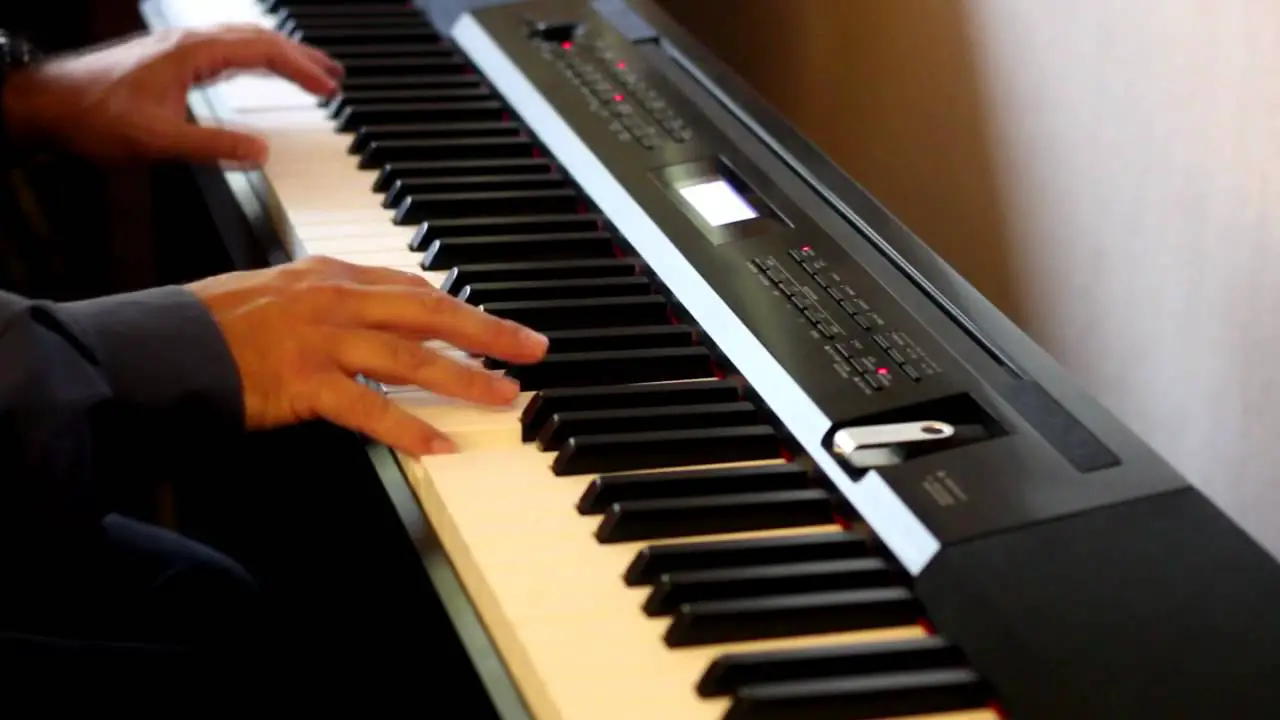
Please click image for more info
The Casio PX-350 is part of Casio’s Privia line of digital pianos. This digital piano offers a keyboard made up of 88 hammer action keys that feature three sensitivity levels. The digital piano is sold with a music stand, a score book, and an SP-3 pedal, and it comes with a long line of special sounds and features. It also builds upon Casio’s Privia tradition of creating an uncannily accurate grand piano sound on a digital piano.
Table of Contents
- Design of Casio Privia PX-350
- Video Overview of Casio Privia PX-350
- Specifications of Casio Privia PX-350
- Pros & Cons of Casio Privia PX-350
- AiR- Acoustic and Intelligent Resonator
- Key action of Casio Privia PX-350
- Special Sounds and Features of Casio Privia PX-350
- Some possible criticisms
- Alternatives
- Cosmo Music’s Casio Privia PX-350 Review
- Conclusion
Design of Casio Privia PX-350
The Casio Privia PX350 has a stylish and simplistic body with keys that comprise most of the surface area. There are many convenient buttons on the keyboard which grant access to all of the features and functions. In terms of visuals, this keyboard is very stylish and aesthetically pleasing. You can choose between the white finish and the matte black finish. Though they reflect different styles, both colors come with their own appeal.
This keyboard houses 88-fully weighted keys textured with ebony and ivory. Not only do the keys feel great to play on, but their high-quality texture provides a better grip for your fingers. If you don’t already have a keyboard stand, there’s an optional stand you can buy that also comes in black and white.
A convenient three-pedal unit is available to buy with the keyboard. Using one sustain pedal reaps many benefits, but when pianists experience three-pedal units, they often realize and appreciate the true potential.
At 25 lbs, The PX-350 is lightweight, and indeed on the radar of excellent gigging keyboards. Performing musicians tend to travel with units weighing 30 lbs or less to minimize hassle. The PX-350’s portable design makes it near perfect for gigging. On top of portability, this digital piano has modest dimensions and easily fits in tight areas. Regardless of the room size, the PX-350 delivers a high-quality playing experience.
Video Overview of Casio Privia PX-350
Specifications of Casio Privia PX-350
The Casio PX350 features a total of 250 sounds, which is quite impressive considering the quality of each sound. With this number of sounds, you’ll have a considerable amount of inspiration to create and experiment. The tones divide into several instrument categories that are easily accessible.
The keyboard has three different touch control levels for you to choose, depending on your dynamic preferences. 128 notes of polyphony give users lots of creative freedom to layer and design unique sounds and songs.
Another excellent aspect of this keyboard is the unrivaled 17-track recorder. Among other keyboards in the price range, this many recording tracks is highly uncommon.
You’ll likely enjoy the stellar sound effects, including 4 chorus types, 4 reverb types, damper resonance, an auto harmonizer, pitch-bend wheel, and a brilliance setting. After finding your ideal sound settings, you can jam along to six different demo songs and indulge in 300 music presets. These built-in songs are entertaining, but can also be excellent for practicing.
There are two 5.1″ by 2.4″ speakers on the PX-350 that produce 8W of power, which is plenty for home use. On the back of the keyboard, you’ll find several inputs, including a USB A and B, MIDI in/out, damper, line in/out, and two headphone jacks. These jacks are vehicles for you to expand your keyboarding ventures.
You have access to useful modes, including layer, split, octave shift, and duet. With the 128-note polyphony, there is plenty of room for sound layering, and you’ll likely never exceed this limit.
A few other convenient features like transposition, fine-tuning, and the metronome can help you achieve more effective practice. This keyboard also harbors a backlit LCD to simplify navigation.
Pros & Cons of Casio Privia PX-350
|
PROS |
|---|
|
|
CONS |
|---|
|
AiR- Acoustic and Intelligent Resonator
The beautiful sound of the Casio PX-350 is in part achieved thanks to the ingenious AiR technology offered by Casio. The Acoustic and Intelligent Resonator system is Casio’s solution to interpolating various velocity-switched sample levels that give the PX-350 same sound as that of a grand piano.
The AiR system allows for better control and smooth dynamics. In combination with Casio’s Damper Resonance, the AiR system makes for one of the richest sounding digital pianos out there.
Key action of Casio Privia PX-350

Not only does Casio aim for realism in terms of the sound of the PX-350, but also in terms of the feel of the keyboard for the player. The 88 keys of the PX-350 feature Tri-sensor scaled hammer action.
Keys are designed to mimic the look and feel of ebony or ivory. Casio has achieved an extreme in key sensitivity and realism by taking into account how the hammers of an acoustic grand work in relation to the speed and force with which keys are pressed.
Special Sounds and Features of Casio Privia PX-350
There are 250 different instrument tones built into the PX-350. Among the built-in instruments are strings, bass, drums, brass, and organ sounds. This digital piano from Casio also comes with 180 drum patterns that can provide accompaniment. Composers using the PX-350 can take advantage of the 17-track recorder that comes built in.
Transposing keys is easy thanks to he a 25 step key transpose feature. Four different types of reverb and four different types of chorus effects allow the player to achieve a many different sounds. The PX-350 is a good choice for student pianists thanks to its built-in metronome with a wide range of tempo settings.
Other features include 1/4″ audio outputs that allow the digital piano to be hooked up to recording or sound reinforcement equipment. The Casio PX-350 also includes a thumb-drive dock that allows performances to be recorded directly onto a drive.
Some possible criticisms

Some users of the Casio PX-350 have complained that the button layout feels somewhat crammed and confusing.
However, this is a natural consequence of a digital piano offering such a wide variety of special effects and features. Another criticism of the digital piano is that its internal speakers show a noticeable compression effect at loud volume settings.
Altogether, the Casio PX-350 is just one more model that showcases the striking realism and impressive value that have become standard features of Casio’s Privia line of digital pianos.
Alternatives
Yamaha P115
The Yamaha P115 is an excellent alternative to the Casio PX-350. Like the PX-350, the P115 has 88-fully weighted keys with matte black keytops. Including four touch sensitivity options, compared to the PX-350’s three, the P115 offers slightly more touch customization. There are also 50 built-in songs to play along with, plus 14 more demo songs. Though some aspects of the P115 outperform the PX-350, there are other areas where the Yamaha keyboard lacks. You have access to only two recording tracks, compared to the Casio PX-350’s 17 tracks. For musicians who value advanced recording options, this difference is significant. You can create nice piano songs with two tracks, but with 17, you can craft a musical masterpiece. Nevertheless, the Yamaha P115 is a solid alternative to the PX-350 in terms of sound.
Yamaha DGX-660
Another great alternative to the Casio PX-350 is the Yamaha DGX-660. The soundbank of the DGX-660 is over twice the size of the PX-350’s and features an impressive 554 built-in sounds. If you’re a beginner, you may also take advantage of the Yamaha Education Suite that’s integrated into the piano. With two 6W speakers, the DGX-660 has slightly less volume power than the PX-350. One thing you may enjoy about this digital piano is the Graded Hammer Standard action of the keys. This action is a classic Yamaha feature that doesn’t disappoint. Though this keyboard doesn’t have the PX-350’s 17 track capabilities, you’ll have decent recording options with a 6-track MIDI recorder.
Cosmo Music’s Casio Privia PX-350 Review
Conclusion
The Casio PX-350 is a beautifully designed digital keyboard that offers outstanding sounds and unrivaled recording potential. You can use this piano at home or for professional use. Pianists of all levels commend the world-class AiR sound engine for the rich and authentic tones it produces. Ebony and Ivory keytops provide the optimal feel and grip, which is similar to Grand Pianos.
Since the keyboard is compact and lightweight, you’ll have no problems putting it in a small space or taking it on the road. The Tri-Sensor Scaled Hammer Action II offers smooth touch for every single key. One of the most impressive attributes of the PX-350 is the recording hardware. Composers and recording enthusiasts alike will love the vast potential of 17 tracks. Many keyboards in the same price range can’t compare and often feature less than 6 recording tracks. With loads of fantastic features at a reasonable price, the Casio PX-350 is a powerful machine fitted for amateur and professional pianists.

